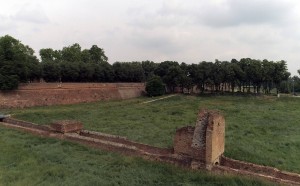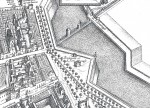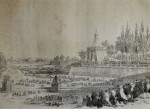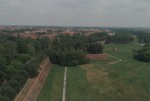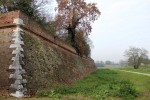Baluardo di San Tommaso and ‘doccile’
Built in the late 1520s to protect the larger Baluardo della Montagna, the Baluardo di San Tommaso is relatively unchanged today, maintaining its original shape aside from the upper embrasures, which have all been filled in.
A small aside
The Baluardo di San Tommaso (Bastion of Saint Thomas) takes its name from the neighbouring church of San Tommaso (which was destroyed in 1836), located within the walls at the intersection of the present-day Via Sant'Andrea and Via Formignana. With its characteristic ‘arrow’ shape, lacking curved ramparts, the bulwark was built in the late 1520s, when Duke Alfonso I d’Este (1476-1534) decided to strengthen the defensive system along the city's south-eastern sector. After having demolished the nearby Pioppa suburb, military engineer Sebastiano Bonmartini of Monselice (alias: Barbazza) oversaw the construction of the new city walls, reusing the building materials from the old curtain walls and a few monasteries that were located in the quarter.
The structure was created to protect the northern side of the larger Baluardo della Montagna, and its military function can be deduced from the presence of the large interior blockhouse, originally used as a deposit for weapons and powdered sulphurs (the entrance to which was enlarged at a later date, and is today covered by metal grating). The gun firing positions that once marked the upper perimeter of the wall are no longer visible.
A short distance away is the eighteenth-century ‘doccile’ of San Tommaso, a sort of canal or duct that was built in 1524 with a vaulted ceiling, in order to convey the waste from the city’s sewers to the Naviglio di Baura canal.
19 June 1661: a dark event at San Tommaso
In this very location, between the water-filled rampart and the fortified tower, in June 1661 a dark event took place, one which comes to us today via the pages of Girolamo Baruffaldi’s Istoria di Ferrara (published in 1700): a woman ordered her lover to murder her husband, though in the end the two criminals would not escape their fate. A ‘notable case’ as described by Baruffaldi, one ‘worthy as a shared example to serve for posterity and teach men that the Justice of God, even when delayed, shows itself in the punishment of misdeeds, and certainly never forgets, punishing perhaps even more fiercely for the wait’.
According to the author,
it was a murder ordered by the very wife herself of Giacopo Moro, her husband, soldier of this garrison, on the night of nineteen June, at the hands of Francesco Pezzolla of Catanzaro, also a soldier serving alongside the aforementioned, and paramour of the woman mentioned, doing him in suddenly with an axe while they ate dinner together. As if not enough, the evildoer, to conceal his ungodly, wicked deed in the worst way, barbarously, with the very same axe, severed the head, arms and legs from the body, closing the dismembered flesh in a sack, and throwing it in the closest hiding place: the trench surrounding the city near the Baluardo di S. Tommaso. There the body of this atrocious crime remained, among the water and the reeds of the swampy site, buried for some time. Thus, the murderer was able to give rise to his amorous gestures, without fear of reproach, as both the wife of the poor man and the murderer himself told anyone who inquired about the deceased, that he had escaped elsewhere, and to others, that, for amusement, he had managed to stay away for a few months; but that soon he would return. To the contrary, when they believed their happiness was settled, the Justice of God, which never sleeps, found a strange way to expose the wicked event and shatter their ill-founded joy.
With that, it so happened that after a month, a fisherman was fishing in the city's waterways (something that rarely happens, and which is cautiously granted to the few) and, navigating the places where he thought fishing would be best, he reached the Baluardo di San Tommaso. In investigating the best place to carry out his pursuit, he happened to look over into the thickest of reeds, where he barely made out the sack holding the flesh of the miserable soul. And, seeing as human avarice always seeks satisfaction, he surmised it concealed something else entirely, so he turned his boat towards that area. Anxiously opening the sack, he discovered, with awe and terror, the rotten flesh of a man, and surprised by the ominous discovery, he well decided not to stop there, and to inform the Criminal Authority, who rushed to the scene and found the body of the crime, but so badly altered that it was no longer possible to distinguish just who the cadaver once was.
The unknown person forced the Minister of Justice to expose it to public view, so that no way of investigating the truth was left unturned, and so that the event would come to light, about which word was spread, so that all types of people converged on the place where the almost-putrefied corpse was displayed in order to identify it. However, there wasn’t a single man or woman able to identify him or that, recognising him, wanted to come forward; it was only observed that a soldier (and this was the cruel murderer to whom such boldness came) among the infinite crowd, that had arrived, in approaching the severed limbs, the colour changed on his face, and, forcing himself even in spite of Nature, despite his horror, to persevere in looking once again upon that dissected body, the force of the antipathy that passed between him and the dead man, blood violently gushed from the nostrils of the present culprit, and, at the same time, from the dead, almost decayed flesh of the displayed man, blood began to exist and bubble up as if alive. And if very few noted this unpleasant effect, there were some who saw it quite well, and in both this last, posthumous explanation set aside by God for the dead man to demonstrate who the culprit was, and for the living man to remain bewildered. Whence not healed, he left, and once the Ministers were informed of the event, they quickly captured the murderer, who was found in the very house of the aforementioned woman. Once in prison, he was forced, upon torture, to state the truth and confess to his barbaric misdeed. A few days later, as a punishment, he paid for the man's life with the torment of cutting his right hand, the pincers, and of the club atop an infamous gallows in public view.
Rendered cautious by the imminent scourge, the woman escaped, as the murder had already occurred, but not long did she remain, for soon word spread through the city that she had been found in a forest - devoured more by wild beasts than internal regret. Suffice it to say that she also paid, dying lacerated apart, the price for her incredible cruelty.
A Pope on the Baluardo di San Tommaso
In July 1857, Ferrara gave Pope Pius IX a rather spectacular welcome, during the very time when the reclamation work was being done on the ditches surrounding the city, with the creation of a canal at the base of the road covered by the counterscarp. Called the ‘Bonificazione Piana’ (in honour of the Pope), this plan also involved vast expanses of Ferrara's farmlands and countryside. Having arrived at the Baluardo di San Tommaso, the Pope approached the city wall to bless the hundreds of workers intent on levelling and regulating the reclaimed land: Ferrara's last salute to a Pope-king before the Unification of Italy.
From the outside, the walls and entrenchments stretch towards the north into an extensive natural environment, recovered after felling a grove of poplars, and following other reclamation works towards the end of the 1970s.
Bibliography
- Baruffaldi, Girolamo, Dell 'istoria di Ferrara scritta dal dottore D. Girolamo Baruffaldi Ferrarese libri nove : ne' quali diffusamente si narrano le cose avvenute in essa dall'anno MDCLV fino al MDCC con gli argomenti à ciascun libro, e due tavole, de'nomi proprj, e delle materie, Bernardino Pomatelli, Ferrara 1700 Vai al testo digitalizzato
- Le feste di Ferrara a Sua Santità Pio Nono, Ferrara 1857
- Francesco Scafuri, Le mura di Ferrara. Un itinerario attorno alla città, tra storia ed architettura militare, in Maria Rosaria Di Fabio (a cura di), Le mura di Ferrara. Storia di un restauro, Minerva, Bologna 2003
Fototeca
Related Themes
Compiling entity
- Assessorato alla Cultura e al Turismo, Comune di Ferrara

